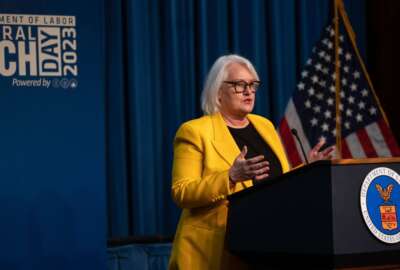Inside the Reporter’s Notebook is a weekly dispatch of news and information you may have missed or that slipped through the cracks at conferences, hearings and other events. This is not a column or commentary — it’s news tidbits, strongly-sourced buzz, and other items of interest that have happened or are happening in the federal IT and acquisition communities.
As always, we encourage you to submit ideas, suggestions and, of course, news to Jason via email.
Be the first to know when a new Inside the Reporter’s Notebook is posted. Sign up today for our new Reporter’s Notebook email alert.
Maybe it’s time for agencies and industry to get some professional help.
Someone who could help each party communicate about their fears, needs and, maybe most of all, assist them in listening to the other side.
A year into Office of Federal Procurement Policy administrator Anne Rung’s vision of where she wants to take federal procurement during her tenure, industry and government communication continues to struggle.
Rung made improving contractor and agency communication a central theme in her Dec. 4, 2014 memo detailing her plans.
She highlighted three broad concepts in that strategy:
- Category management — OFPP defined it as the need to “drive performance, like developing common standards in practices and contracts, driving greater transparency in acquisition performance, improving data analysis, and more frequently using private sector (as well as government) best practices.” OFPP and the General Services Administration highlighted their progress in an October 2015 blog post.
- Acquisition workforce talent development
- Stronger vendor relationships
So I decided, on the suggestion of an industry friend, to check-in on the progress agencies are making on each of these areas with several federal acquisition experts.
Read more
With all apologies to President Ronald Reagan’s historic 1987 speech in West Berlin, the General Services Administration should take a page from Dutch and open up its e-Buy program to the public.
GSA hides task orders behind its version of a “pay wall” — vendors must spend upwards of $25,000 to get on a schedule contract and see what they are missing.
GSA took an initial step in June when it made older task orders available to federal agencies.
Tom Sharpe, Federal Acquisition Service commissioner, said in July GSA would open up e-Buy to the general public by the end of the year.
Well, here we are, almost to the end of the year and progress has slowed.
So Mr. Sharpe, it’s time to open e-Buy to the public once and for all.
It’s a transparency issue. It’s a fairness issue. It doesn’t make sense to keep these task orders private, especially when more and more agencies are driving procurements through these vehicles.
In 2015, agencies spent more money through GSA’s schedules and governmentwide acquisition contracts than then the previous year. Final 2015 spending numbers are not final yet, but GSA officials have said many times publicly they expect spending on schedules and GWACS in 2015 to increase significantly.
Read more
A recent tweet by Michael O’Rielly, a Federal Communications Commission commissioner, congratulating the agency on moving to Internet Protocol version 6 (IPv6), got me thinking, whatever happened to that effort?
Where do agencies stand a decade after the White House first called on agencies to adopt this more secure protocol?
It was so important, at one time, that the Office of Management and Budget issued two memos requiring agencies to move to the more secure, better protocol on the network backbone. The CIO Council also stood up a working group, issued how-to guides, and there were the assorted conferences, talks and lunches about the importance of IPv6.
The first time OMB mandated agencies move was in 2005, giving them a 2008 deadline. Then two years after most agencies missed the 2008 deadline, OMB came up with two more deadlines: By 2012, agencies must upgrade public or external facing services and services; and by 2014, they must upgrade internal client applications that communicate with public services or support enterprise networks.
Nearly a decade in the making, the latest statistics from the National Institute of Standards and Technology show quietly agencies are leading industry.
Read more
Even before agencies have finalized how they will implement the Federal IT Acquisition Reform Act, two lawmakers are pushing for more.
Sens. Bill Cassidy (R-La.) and Gary Peters (D-Mich.) introduced the Making Electronic Government Accountable by Yielding Tangible Efficiencies (MEGABYTE) Act of 2015 to reform the government’s management of IT software licenses.
While FITARA was much broader, Cassidy and Peters believe the government could save $4 billion a year by better managing licenses.
“Billions of taxpayer dollars could be saved if federal agencies keep track of what software they buy. It’s irresponsible they don’t do so already,” said Cassidy in a Dec. 7 release. “Tax dollars could be better used on our troops and our classrooms, not redundant software licenses.”
Cassidy and Peters introduced the bill Dec. 2 and it was referred to the Homeland Security and Governmental Affairs Committee.
Read more
Copyright
© 2024 Federal News Network. All rights reserved. This website is not intended for users located within the European Economic Area.





